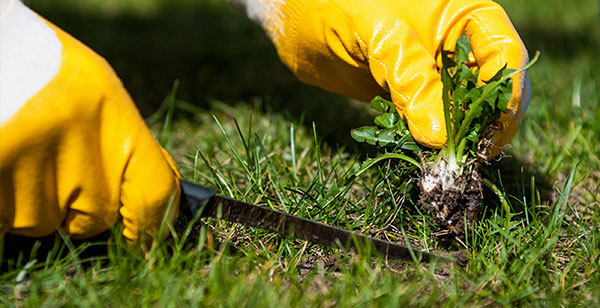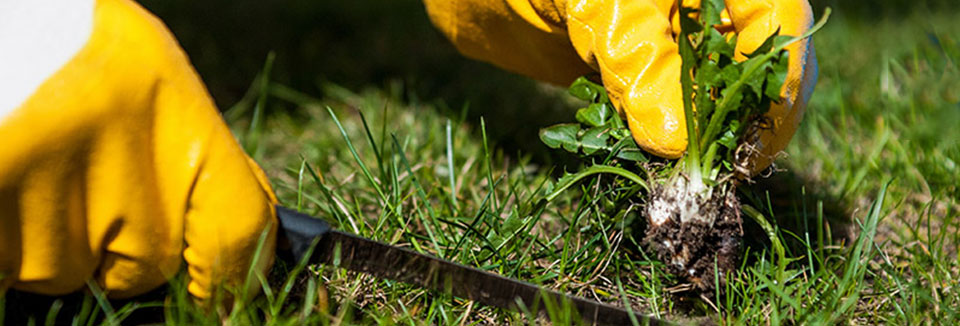Weed Control: The How to Guide
This season, don’t let weeds get the best of your lawn. From dandelions to quack grass, there are several different types of weeds that can be easily prevented or removed with a specific treatment.
With this how-to guide from Briggs & Stratton, you will learn about lawn weed types and also a better understanding of different weed control solutions.
A Healthy Lawn Prevents Weeds
Preventing weeds helps you to maintain a beautiful lawn. Thick, healthy grass prevents weeds from stealing the nutrients needed to thrive; water and sunshine. Also:
While mowing the lawn, whether you’re using a riding mower or a push mower powered by a Briggs & Stratton engine, never cut more than one-third off of the leaf blade. This ensures an even cut and will prevent against this issue known as scalping. Scalping can cause irreparable lawn damage for the season and promotes weed growth.
Water the lawn early in the morning, a few times each week, adding up to about an inch of water. Longer, healthier grass is more resilient to weed growth.
Fertilize your lawn to help create a robust grass root system that makes it a difficult environment for weeds to thrive. An ideal frequency is 4 to 5 times per year but depends on the type of ingredients you’re using.
When planting seedlings and sodding spotty grass, your lawn is in danger of weeds. Understanding how to weed and feed your lawn will protect baby grass from weed overgrowth.
Herbicides & Weed Control
A well-maintained and healthy lawn is a good start, but, weed sprouts can still crop up. And herbicides are one way to control an outbreak.
- The three main herbicide ingredients are Mecoprop, 2 4-D, Dicamba. When used in different combinations, these ingredients kill weeds and provide overall weed control.
The toughest kinds of weeds such as crabgrass, sedges and broadleaf weeds, can be effectively controlled/prevented with products using quinclorac as an active ingredient.
To kill anything green, including grass, use glyphosate, the non-selective weed killer. Best for cracks in the sidewalk or driveway.
Carefully follow all safety precautions for all herbicides used.
While herbicides are one option, another alternative to weed control is removal with a straight screwdriver and pull weeds out of the ground by hand. Although this will take some effort, it provides effective control and helps prevent weeds from spreading.
Lawn Weed Types
The broadleaf weed and the grassy weed are the two basic types of unwanted plants you will find in your yard. These can be eliminated by combining herbicide ingredients and lawn care in different combinations. Remember fall is the best time to for broadleaf weed control and spring is the best time for grassy weed control.
Check out different types of lawn weeds to identify what is growing in your yard:
Lawn Weed Types |
Description | Weed Control |
| Annual Bluegrass |
|
You may choose to manage annual bluegrass rather than try to eradicate it. Because its most distinct difference is its yellowish color, regular fertilization of your lawn can help mask its presence. Any dead patches in your lawn must be seeded quickly to prevent annual bluegrass from growing back. |
| Virginia Button Weed |
|
If any portion of its below-ground-stem remains after hand-pulling or herbicide application, it can produce another plant. Controlling Virginia Button weed with herbicides usually requires more than one application in the same season. |
| Smooth Crabgrass |
|
Apply herbicide in the spring, before soil temperatures become ideal for growth. If crabgrass has already started growing, a different variety of herbicide designed for mature plants is needed. |
| Quack Grass |
|
Thriving in cool climates, quack grass flourishes in under-fertilized lawns. It can quickly spread from neighboring yards, but it often hitches along with nursery stock, or contaminated mulch and topsoil. There are no herbicides designed for quack grass. If you see a plant, remove it right away or spot-spray it with an herbicide glyphosate (which will kill all green). |
| Spotted Spurge |
|
Common in high-traffic areas, the spotted spurge is a good indicator of compacted soil and will even grow in the cracks of sidewalks if it has enough moisture. It thrives throughout the spring and summer. Eliminating compact soil and ensuring proper mowing height will create a healthy lawn, resistant to this weed. Herbicides in the spring can prevent its initial growth, and are effective when the weed plant is young. |
| Large Crabgrass |
|
Apply herbicide in the spring, before soil temperatures become ideal for growth. If crabgrass has already started growing, a different variety of herbicide designed for mature plants is needed. Eliminating mature plants in the late summer is very difficult, but they will die with the first frost. |
| Broadleaf Plaintain |
|
Broadleaf plantain is not easily pulled from the ground because of its thick taproot. Even when treated with an herbicide, broadleaf plantain often has large carbohydrate stores in its roots which allow it to survive. The leaves may shrivel and disappear after herbicide application, but the weed may regrow within a few weeks. |
| Dandelion |
|
Apply herbicide in fall, just before or right after tree leaves fall, The herbicide’s active ingredients move directly to the root system, which is the only part of the weed that’s still growing at this time. You won’t see many dandelions dying in fall as the plant stores energy for next spring, but be assured the herbicide is killing the root system. |
| Dallis Grass |
|
Dallis grass is a tough weed to control once already growing in your yard. There are very few herbicides, especially those available to homeowners, which will selectively control Dallis grass within other warm-season grasses. The active ingredients foramsulfuron and sulfosulfuron have been shown to provide some control. |
Refer to the lawn weeds chart throughout the season for control over unwanted plants. To learn more about how to maintain a healthy, weed-free lawn, find a Briggs & Stratton Dealer in your area today!






